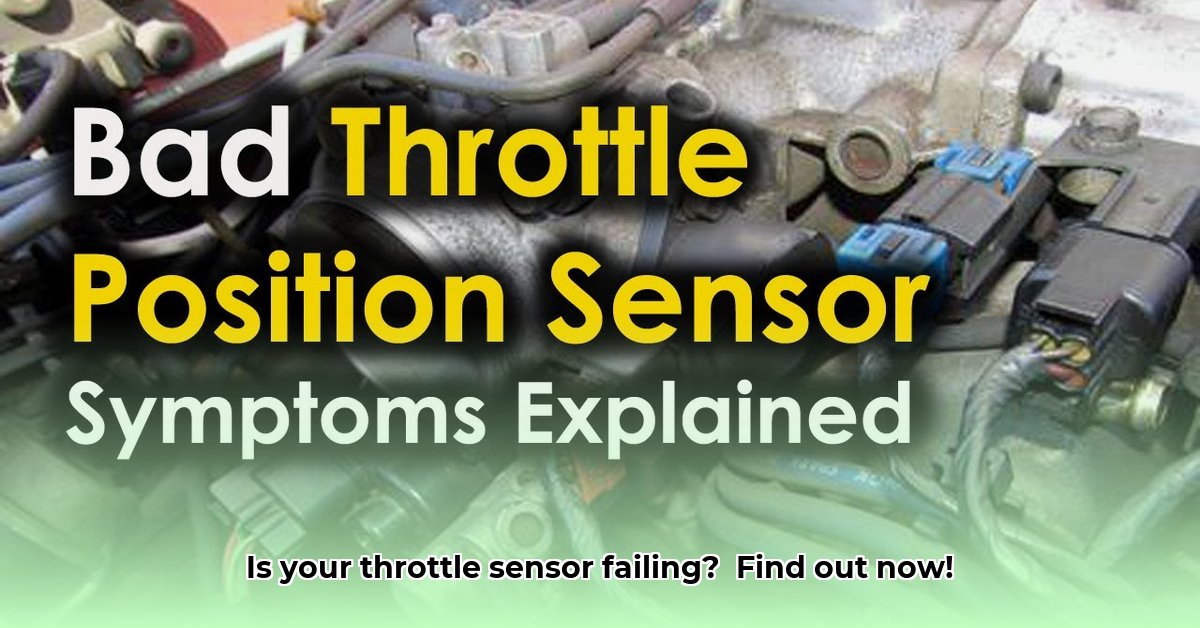Is your car not performing as it should? Experiencing hesitation when accelerating, rough idling, or even stalling? A faulty throttle position sensor (TPS) could be the reason. This comprehensive guide will walk you through recognizing the symptoms of a failing TPS, checking for trouble codes with an OBD-II scanner, performing simple tests with a multimeter, understanding potential causes, and knowing when to seek professional assistance. We’ll cover everything from erratic acceleration and decreased fuel economy to Diagnostic Trouble Codes (DTCs) and step-by-step replacement instructions. Whether you’re a seasoned mechanic tackling a challenging repair or a curious car owner aiming to understand your vehicle better, this guide is designed to help you diagnose and potentially resolve TPS-related issues efficiently.
Recognizing the Tell-Tale Signs of a Faulty Throttle Sensor
A failing throttle position sensor (TPS) can manifest in a variety of noticeable ways, significantly impacting your vehicle’s performance. Because the sensor plays a crucial role in relaying throttle valve position to the engine control unit (ECU), its malfunction can lead to a cascade of problems. These symptoms indicate an issue that demands attention. Recognizing these signs early can save you from more extensive and costly repairs down the road. So, what are the most common warning signs of a failing TPS?
- Inconsistent or Rough Idling: A shaky, rough, or uneven engine idle, especially when the car is stationary or in park, is a common early indicator of a potential TPS issue. The engine might vibrate more than usual, sounding rough and unsteady, suggesting the TPS isn’t providing the correct air-fuel mixture information to the ECU. This often results in the engine struggling to maintain a consistent idle speed.
- Sudden Stalling or Hesitation: If your car hesitates noticeably upon acceleration or stalls unexpectedly, particularly at low speeds or when coming to a stop, it could be due to conflicting signals from the TPS. This causes the engine not to receive the necessary air and fuel mixture at the correct time. This loss of power can make driving unpredictable and unsafe, significantly impacting overall driving performance.
- Erratic or Unpredictable Acceleration: Unreliable acceleration, characterized by periods of sluggishness followed by sudden bursts of speed, is another frustrating symptom directly tied to the engine receiving inconsistent instructions about the optimal air supply. This can make maintaining a steady speed challenging, and the car may feel as if it is operating outside of your direct control. You might notice this symptom more prominently when attempting to merge onto a highway or pass another vehicle.
- Decreased Fuel Economy: If your car suddenly starts consuming more fuel than usual without any changes in driving habits, a failing TPS could be the culprit. A faulty sensor can cause excessive fuel usage by feeding the engine an incorrect air-fuel mixture, often injecting more fuel than necessary. This occurs because the ECU constantly requests more fuel based on the faulty TPS readings, even when it’s not actually needed.
- Check Engine Light Illumination: The check engine light, often accompanied by a Diagnostic Trouble Code (DTC) usually within the range of P0120 to P0129, is a clear indicator that something is amiss within your throttle position system. These DTCs provide valuable information for diagnosing the underlying problem and accurately identifying the faulty component within the system. Use an OBD-II scanner to retrieve these codes for a more informed diagnosis.
- Difficulty Shifting Gears (Automatic Transmissions): In vehicles equipped with automatic transmissions, a faulty TPS can disrupt the smooth shifting of gears. The transmission control unit (TCU) relies on the TPS signal to determine the appropriate shift points. When the TPS signal is erratic or inaccurate, it can lead to harsh, delayed, or unpredictable gear shifts.
- Surging: You might notice your car slightly accelerating and decelerating on its own, even while trying to maintain a constant speed.
Understanding the Causes of TPS Failure
Several factors can contribute to the premature failure of a throttle position sensor. Understanding these causes can help you take preventative measures and potentially extend the life of your TPS.
- Normal Wear and Tear: Over time, the internal components of the TPS can simply wear out due to constant use and exposure to engine heat. The sensor’s moving parts can degrade, leading to inaccurate readings.
- Contamination: Dirt, debris, oil, and other contaminants can infiltrate the TPS housing, interfering with its operation. These contaminants can disrupt the sensor’s electrical connections or physically obstruct its movement.
- Moisture Intrusion: Exposure to moisture, whether from engine bay cleaning or environmental factors, can cause corrosion and short circuits within the TPS.
- Electrical Issues: Problems with the wiring harness connected to the TPS, such as frayed wires, loose connections, or corrosion, can disrupt the sensor’s signal and lead to failure.
- Physical Damage: Impact from road debris or accidental damage during engine maintenance can physically damage the TPS, rendering it inoperable.
Diagnosing a Faulty TPS: Code Reading and Testing Procedures
Suspect a bad TPS? Here’s a comprehensive, systematic approach to diagnosis to accurately pinpoint whether it’s causing the performance issues you’re experiencing:
- Retrieve Diagnostic Trouble Codes (DTCs): Use an OBD-II scanner to read any stored Diagnostic Trouble Codes (DTCs) from your vehicle’s computer. Think of this as your car communicating potential issues occurring under the hood. Codes such as P0120, P0121, P0122, P0123, and P0124 are commonly associated with TPS problems. Note down all codes present, as they provide important clues for troubleshooting.
- Perform a Thorough Visual Inspection: Carefully examine the TPS, its wiring harness, and its connector for any signs of physical damage or corrosion. Check for cracked housings, frayed wires, loose connections, or any other visible abnormalities. A visual inspection can sometimes quickly reveal obvious problems.
- Check the Reference Voltage with a Multimeter: A multimeter is essential for electrically testing the TPS. First, verify that the TPS is receiving the correct reference voltage (typically 5 volts) from the ECU. Disconnect the TPS connector, turn the ignition to the “ON” position (engine off), and use the multimeter to measure the voltage between the reference voltage wire and ground. Refer to your car’s repair manual for the specific wire identification.
- Test the Signal Voltage: With the TPS connector still disconnected and the ignition on, use the multimeter to measure the output signal voltage while manually moving the throttle plate through its full range of motion. The voltage should change smoothly and linearly, without any sudden jumps or dead spots. Compare your readings to the specifications in your vehicle’s repair manual. Erratic or inconsistent voltage readings indicate a faulty TPS.
- Test the Resistance: Similar to the voltage tests, this step utilizes a multimeter to check the resistance of the TPS. Disconnect the TPS connector and use the multimeter to measure the resistance between the appropriate terminals, as specified in your vehicle’s wiring diagram. The resistance should change smoothly and predictably as you move the throttle plate. Compare your results to the values outlined in your repair manual.
According to RepairPal, the average cost to replace a throttle position sensor ranges from $171 to $254, including both parts and labor costs. However, this price can fluctuate depending on your specific vehicle model and the labor rates in your area.
Repairing or Replacing Your TPS: Step-by-Step Instructions
In some cases, carefully cleaning the TPS with a specialized electronic component cleaner can temporarily resolve minor issues caused by contamination. However, most often, when a TPS fails, a complete replacement is the most reliable solution.
General Steps for TPS Replacement:
Important Note: These are general guidelines. Always refer to your vehicle’s specific repair manual for detailed instructions, torque specifications, and safety precautions.
- Prioritize Safety: Disconnect the negative battery terminal using a wrench to ensure safety before working on the car’s electrical system. This prevents accidental short circuits or electrical shocks during the repair process. Wait at least 10 minutes after disconnecting the battery before proceeding to allow any residual electrical charge to dissipate.
- Locate the Throttle Body: Consult your vehicle’s repair manual to accurately locate the throttle body and the TPS, as their positions can vary significantly between different makes and models. The TPS is typically mounted directly on the throttle body.
- Disconnect Electrical Connectors and Vacuum Lines (If Applicable): Carefully unplug the electrical connector(s) connected to the TPS. Some vehicles may also have small vacuum lines attached to the throttle body that need to be disconnected. Take note of their routing for easy reinstallation. Use a small screwdriver or pliers if necessary to gently detach any vacuum lines.
- Remove the Old Sensor: Use the appropriate socket or wrench to carefully remove the screws or bolts securing the TPS to the throttle body. Be gentle to avoid stripping the screws or damaging the throttle body. Once the fasteners are removed, carefully detach the old TPS from the throttle body.
- Install the New Sensor: Position the new TPS onto the throttle body, ensuring it’s properly aligned with the mounting holes. Secure it with the screws or bolts you removed earlier, tightening them to the torque specifications outlined in your vehicle’s repair manual. Correct alignment and proper torque are crucial for the sensor to function correctly and provide accurate readings to the engine control unit.
- Reconnect and Reassemble: Reconnect all electrical connectors and vacuum lines (if applicable), ensuring that the connections are secure and properly seated. Double-check the routing
- Why an App Appeared on My Phone Unexpectedly - November 22, 2025
- How to Stop Unwanted Apps from Automatically Downloading on Android - November 21, 2025
- Why Are Android Games Installing Themselves on Your Phone? - November 20, 2025










